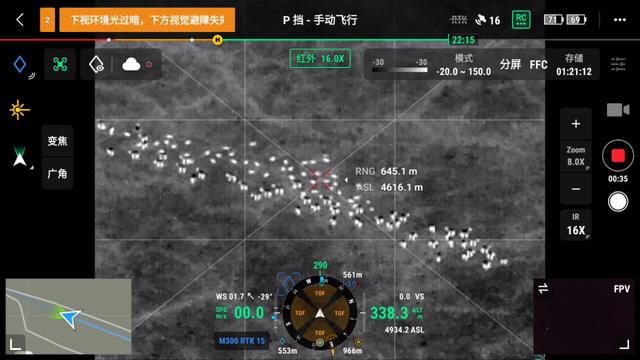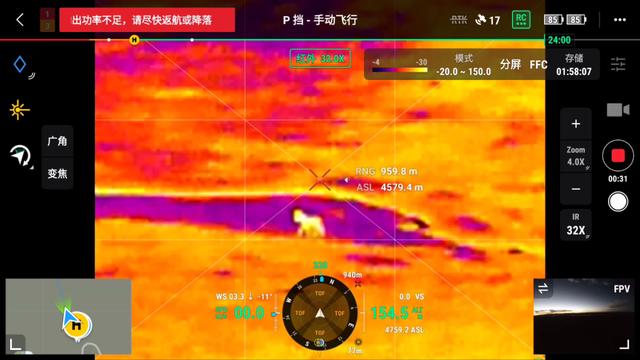Shenzhen: DJI's latest drone infrared thermal imaging function fills wildlife night observation gap at night
Author:Yangcheng Evening News Yangche Time:2022.08.28
Text/Yangcheng Evening News all -media reporter Shen Tingting
A few days ago, DJI engineers and the Northwest Plateau Institute of the Chinese Academy of Sciences (hereinafter referred to as the "Northwestern Plateau Institute of the Chinese Academy of Sciences") scientific research team conducted wild animal science investigations in the unmanned area of the unmanned area of Coco, Sanjiangyuan National Park. The drone system, for the first time on the plateau at 4,600 meters above sea level, observe the night behavior of Tibetan antelopes, Tibetan wild donkeys, rock sheep and other rare species. The functions of the Tibetan antelopes have a long -term and unrecommiated mobile tracking of Tibetan antelopes, providing precious pictures and video materials for the study of Tibetan antelopes at night and migration habits.
Researcher Xinming, the Northwest Plateau Institute of the Chinese Academy of Sciences, said that this is also the first time that the team has used drones to conduct Tibetan antelope clusters for a long time in the past 20 years. Studies such as the choice of preferences and influencing factor in the land of the land have greater the value of scientific research, which provides new means for the launch of night scientific research in the future.
In -depth cocoa Sili helps wildlife investigation and protection
In order to further verify the application prospects and night observation capabilities of the industry's drone system in the protection of plateau animal protection, at the end of July, DJI industry application engineers brought the industry drone and the latest thermal imaging function camera to the area to assist the Northwest Plateau Institute Carry out scientific research investigation.
"We lift the drone to a height of more than 200 meters and sweep the rotor body. Because the temperature at night, the vegetation covers less, and the terrain is very flat. We quickly found a suspected heat source through the H20N infrared thermal imaging lens. "DJI engineers recalled that because of the lack of experience at night tracking in the past, even scientific researchers could not determine what kind of animals were heating objects. If you want to get close to the investigation, the noise of the drone will disturb the animals, but through the latest integrated high -power zoom thermal imaging camera function through the latest integrated high -power zoom in the DJI Camera, you can get a very clear infrared at a distance of more than 500 meters. The picture exceeds the observation distance of most observation equipment.

The video screen shows that the drone's infrared mode captures a bunch of thermal source points, and the center point of the screen is more than 600 meters from the drone. However, when the shooting team increases the infrared zoom multiple, it is finally confirmed that it is a national first -class protective animal Tibetan antelope.
"For the first time, I saw these infrared characteristics. I haven't seen this kind of picture before, and there is no such research direction in my mind." Lian Xinming introduced that the infrared characteristics of Tibetan antelopes look like turtles with long four feet. This is because they have excellent warmth of warmth, and a excellent insulation layer is formed between the body and the environment. Therefore, a low -temperature zone with different colors is formed on the back. Compared with it, the hair is short and sparse. Tibetan donkey (below) is a heat source with uniform temperature. This is a very interesting attempt to identify different species through infrared functions for the first attempt to identify different species through infrared functions.


In addition, because the equipment (H20N) innovatively integrated the thermal imaging function of 8 times optical zoom, it also brought a lot of novel experience to this shooting work. For example, the shooting team found two similar hotspots in the same area. At the beginning, everyone was counted as Tibetan antelopes, but after being enlarged, a subtle difference was found. And there is no infrared characteristics on the back of the Tibetan antelope, it should just be a bed mark, that is, the ground is hot by the Tibetan antelope, which needs to be distinguished when counting. At the same time, these lying marks (above) can also be used to study the night -stay habits of Tibetan antelopes.
Or fill in wild animals at night to actively shoot the work gap
Li Hongbo, a solution engineer in DJI industry, introduced that due to drones to overcome the restrictions of terrain and vision, many cases have confirmed that drone can be well used in wildlife tracking and shooting, such as Yunnan Elephant to north, etc. On the one hand, it is the risk of investigating manpower to reduce investigators on field investigation in the mountains and forest areas. The non -contact characteristics of drones will also reduce the interference of wild animals itself. After the release of the new generation of infrared cameras, the drone at night can be purely hidden observation at a distance of 500-1000 meters away from animals, and can be actively shooting and tracking for up to half an hour.
DJI also said that in the future, it is planned to explore the effectiveness of drones in the field of wildlife protection and contribute to global sustainable development and biodiversity protection.
Source | Yangcheng Evening News · Yangcheng School
Responsible | Yellow Tie'an
School pair | Pan Liling
- END -
Section 192, the number is about to be released!

Source: Xinhua News AgencyChina Radio and Television 5G network service is launche...
Huawei Cloud's AI Deep Dive Journey

Historically, AI technology has experienced two cold winter, the reason is that te...